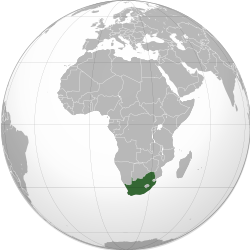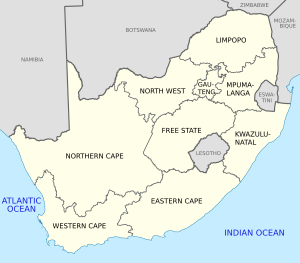Gúúsù Áfríkà

Republiek van Suid-Afrika (Afrikaans) iRiphabliki yeSewula Afrika (S. Ndebele) iRiphabliki yomZantsi Afrika (Xhosa) iRiphabhuliki yaseNingizimu Afrika (Zulu) iRiphabhulikhi yeNingizimu Afrika (Swazi) Repabliki ya Afrika-Borwa (N. Sotho) Rephaboliki ya Afrika Borwa (S. Sotho) Rephaboliki ya Aforika Borwa (Tswana) Riphabliki ra Afrika Dzonga (Tsonga) Riphabuḽiki ya Afurika Tshipembe (Venda) (all 11 names are official)[1] | |
|---|---|
Orin ìyìn: National anthem of South Africa | |
 | |
| Olùìlú | Pretoria (executive) Bloemfontein (judicial) Cape Town (legislative) |
| Ìlú tótóbijùlọ | Johannesburg (2006) [2] |
| Àwọn èdè ìṣẹ́ọba | |
| Àwọn ẹ̀yà ènìyàn | 79.3% Black 9.1% White 9.0% Coloured 2.6% Asian[4] |
| Orúkọ aráàlú | South African |
| Ìjọba | Constitutional democracy |
| Cyril Ramaphosa | |
| David Mabuza | |
| Amos Masondo | |
| Thandi Modise | |
| Mogoeng Mogoeng | |
| Independence from the United Kingdom | |
• Union | 31 May 1910 |
| 11 December 1931 | |
• Republic | 31 May 1961 |
| Ìtóbi | |
• Total | [convert: invalid number] (25th) |
• Omi (%) | Negligible |
| Alábùgbé | |
• 2009 estimate | 49,320,000[4] (25th) |
• 2001 census | 44 819 778[5] |
• Ìdìmọ́ra | 41/km2 (106.2/sq mi) (170th) |
| GDP (PPP) | 2008 estimate |
• Total | $493.490 billion[6] (25th) |
• Per capita | $10,136[6] (79th) |
| GDP (nominal) | 2008 estimate |
• Total | $276.764 billion[6] (32nd) |
• Per capita | $5,684[6] (76th) |
| Gini (2000) | 57.8 high |
| HDI (2007) | 0.674 ▲ Error: Invalid HDI value · 121st |
| Owóníná | Rand (ZAR) |
| Ibi àkókò | UTC+2 (SAST) |
| Ojúọ̀nà ọkọ́ | left |
| Àmì tẹlifóònù | +27 |
| Internet TLD | .za |
Orílẹ̀-èdè Olómìnira ilẹ̀ Gúúsù Áfíríkà wà ní ẹnu igun Apá guusu Áfíríkà. Ó ní ibodè pẹ̀lú orílẹ̀-èdè Namibia, Botswana àti Zimbabwe ní àríwá, mọ́ Mozambique àti Swaziland ní ìlà Òòrùn, 2,798 kilometres (1,739 mi) etí odò ní Okun Atlantiki àti Okun India[7][8], ti Lesotho si budo je yiyika pelu re.[9]
Àwọn Ìgbèríko Gúúsù Áfíríkà[àtúnṣe | àtúnṣe àmìọ̀rọ̀]
Orílẹ̀-èdè Gúúsù Áfíríkà pín sí igberiko 9.
 | ||||||||||||||||||||||||||||||||||||||||||||

|
Àyọkà yìí tàbí apá rẹ̀ únfẹ́ àtúnṣe sí. Ẹ le fẹ̀ jù báyìí lọ tàbí kí ẹ ṣàtúnṣe rẹ̀ lọ́nà tí yíò mu kúnrẹ́rẹ́. Ẹ ran Wikipedia lọ́wọ́ láti fẹ̀ẹ́ jù báyìí lọ. |
Ìrìn-àjò[àtúnṣe | àtúnṣe àmìọ̀rọ̀]
South Africa jẹ orílẹ-èdè kan pẹlu ìtàn àkọọ́lẹ̀ ti ẹlẹ́yàmẹ̀yà; láti igba miiran ti iṣagbega iwa-ipa ti o kọja, orilẹ-ede yii ka lati jẹ idagbasoke julọ julọ lori ilẹ Afirika da duro diẹ ninu awọn aleebu irora.
Ṣugbọn a ko le dinku ilẹ ikọja yii si awọn abawọn itan rẹ: loni, orilẹ-ede jẹ ọkan ninu awọn irin-ajo ti o dara julọ julọ ni agbaye, ni ifamọra ẹgbẹẹgbẹrun awọn ọmọ ile-iwe, ati pe ọpọlọpọ awọn alejo ṣe irin ajo lati ṣe ẹwa si agbegbe ti o dara yii[13].
Àwọn Ìtọ́kasí[àtúnṣe | àtúnṣe àmìọ̀rọ̀]
- ↑ "The Constitution". Constitutional Court of South Africa. Retrieved 2009-09-03.
- ↑ Principal Agglomerations of the World at www.citypopulation.de
- ↑ The Khoi, Nama and San languages; sign language; German, Greek, Gujarati, Hindi, Portuguese, Tamil, Telegu and Urdu; and Arabic, Hebrew, Sanskrit and "other languages used for religious purposes in South Africa" have a special status. See Chapter 1, Article 6, of the Constitution.
- ↑ 4.0 4.1 Statistics South Africa (2009) (.html). Mid-year population estimates. 2009. Stats SA. http://www.statssa.gov.za/PublicationsHTML/P03022009/html/P03022009.html. Retrieved 2009-01-09.
- ↑ "Census 2001 at a glance". Statistics South Africa. Retrieved 2008-07-07.
- ↑ 6.0 6.1 6.2 6.3 "South Africa". International Monetary Fund. Retrieved 2009-10-01.
- ↑ "South African Maritime Safety Authority". South African Maritime Safety Authority. Archived from the original on 2008-12-29. Retrieved 2008-06-16.
- ↑ "Coastline". The World Factbook. CIA. Archived from the original on 2007-06-13. Retrieved 2008-06-16.
- ↑ "Encyclopædia Britannica Online". Encyclopædia Britannica, Inc.
- ↑ "Chapter 6 - Provinces". Constitution of the Republic of South Africa. Government of South Africa. 1996. Retrieved 2009-09-04.
- ↑ 11.0 11.1 Burger, Delien, ed (2009). "The land and its people". South Africa Yearbook 2008/09. Pretoria: Government Communication & Information System. pp. 7–24. ISBN 978-0-621-38412-3. http://www.gcis.gov.za/resource_centre/sa_info/yearbook/2009/chapter1.pdf. Retrieved 23 September 2009.
- ↑ "Community Survey 2007: Basic results" (PDF). Statistics South Africa. p. 2. Retrieved 23 September 2009.
- ↑ "Awọn ibi Lẹwa Ni Gúúsù Áfríkà". Archived from the original on 2021-04-25. Retrieved 2020-09-09.



